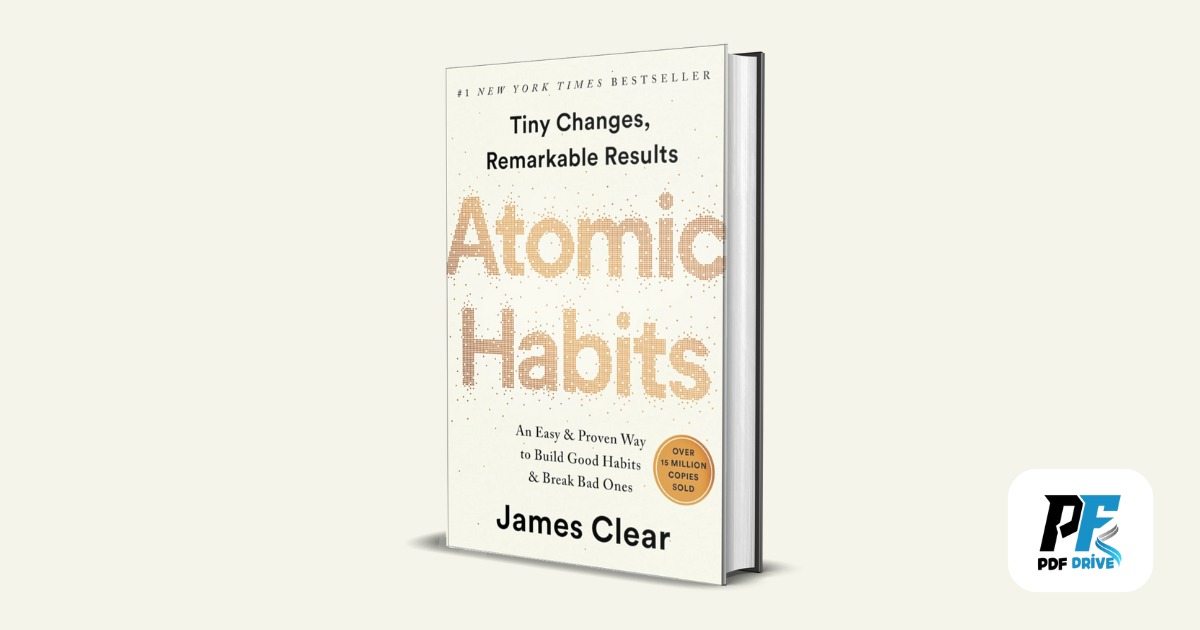Atomic Habits - James Clear

Author: James Clear
Published: October 16, 2018
Publisher: Avery
Genre: Self-help, Personal Development, Psychology
Themes: Habit Formation, Behavior Change, Personal Growth, Productivity, Success
Introduction
Atomic Habits by James Clear is a comprehensive guide to understanding how habits work and how small, incremental changes can lead to significant improvements in your life. The book breaks down the science of habit formation into actionable steps, providing readers with practical tools to build good habits, break bad ones, and ultimately, achieve lasting personal growth.
Clear’s approach is rooted in the idea that success and failure are not the results of big, sweeping changes but rather the accumulation of small, consistent actions. He argues that by focusing on improving by just 1% every day, individuals can experience transformative results over time. The book is filled with examples from real-life case studies, psychological research, and personal anecdotes that illustrate how tiny habits can compound into life-changing outcomes.
The Power of Atomic Habits
Clear begins by explaining the concept of “atomic habits,” which refers to small habits that are part of a larger system of change. He emphasizes that the most effective way to change your behavior is not by setting big goals, but by focusing on the tiny, everyday habits that drive those goals. The book challenges the traditional notion of goal-setting, suggesting instead that we should focus on the systems and processes that lead to the desired outcomes.
Clear argues that habits are the compound interest of self-improvement. Just as money multiplies through compound interest, the effects of your habits multiply as you repeat them. This compounding effect is powerful, but it can also work against you if you maintain bad habits. The key to success, therefore, lies in understanding and harnessing the power of habits to work in your favor.
The Four Laws of Behavior Change
A central part of Atomic Habits is the framework that Clear introduces for habit formation, which he calls the Four Laws of Behavior Change. These laws provide a blueprint for building good habits and breaking bad ones. Each law is a principle that makes habits more or less likely to be formed or maintained.
1. Make It Obvious
The first law of behavior change is to make your habits obvious. This involves increasing the visibility and cues associated with the habits you want to build. Clear discusses the concept of “cue” as the trigger that starts a habit, emphasizing the importance of designing your environment in a way that makes positive cues more prominent.
For example, if you want to start a habit of drinking more water, you might place water bottles in easily accessible locations around your home or workplace. By making the cue (water) more obvious, you increase the likelihood of engaging in the desired behavior (drinking water).
Clear also introduces the idea of habit stacking, where you pair a new habit with an existing one. This technique leverages the power of current routines to establish new behaviors. For instance, if you already brush your teeth every morning, you can stack a new habit, like doing ten push-ups, immediately after brushing your teeth.
2. Make It Attractive
The second law is to make your habits attractive. Clear explains that habits are often driven by a craving for a particular outcome, and by making the habit more appealing, you increase your desire to follow through with it. He discusses the role of dopamine in habit formation, noting that this neurotransmitter is released not only when we experience pleasure but also in anticipation of it.
To make a habit more attractive, Clear suggests using temptation bundling, a strategy where you pair an action you want to do with an action you need to do. For example, if you enjoy watching Netflix but need to exercise more, you might allow yourself to watch your favorite show only while you’re working out. This makes the habit of exercising more attractive because it’s associated with something you already enjoy.
3. Make It Easy
The third law is to make your habits easy to perform. Clear argues that reducing the friction associated with a habit increases the likelihood of maintaining it. This involves simplifying your habits to make them as easy as possible to start. The easier a habit is, the less resistance you will face when trying to adopt it.
Clear introduces the Two-Minute Rule, which states that when you start a new habit, it should take less than two minutes to do. The idea is to make the habit so easy that you can’t say no to it. For instance, if your goal is to start reading more, your habit could be to read one page each night. By making the task extremely manageable, you build the consistency needed to develop a more extensive reading habit over time.
Clear also discusses the importance of automating habits, such as using apps or tools that help you stay on track without requiring much effort. Automation reduces the cognitive load and makes it easier to follow through with your desired behaviors.
4. Make It Satisfying
The fourth law is to make your habits satisfying. Clear explains that humans are wired to repeat behaviors that provide immediate rewards. Therefore, to ensure a habit sticks, it’s important to create immediate, positive reinforcement for completing the habit.
One strategy Clear suggests is using a habit tracker, where you mark off each day you successfully complete the habit. The visual satisfaction of seeing your progress builds a sense of accomplishment and encourages you to maintain the habit. Another approach is to create a reward system, where you treat yourself after reaching specific milestones.
Clear also touches on the idea of “don’t break the chain,” a technique where you try to perform a habit every day without missing a day. The longer you maintain the streak, the more motivated you become to continue, as breaking the chain feels like losing progress.
The Role of Identity in Habit Formation
A significant theme in Atomic Habits is the relationship between habits and identity. Clear argues that the most effective way to change your habits is to focus on who you want to become, rather than what you want to achieve. This shift in perspective means that instead of setting a goal to run a marathon, you would aim to become a runner. By adopting the identity of a runner, every action you take that aligns with this identity reinforces the habit.
Clear emphasizes that habits are not just actions we perform but expressions of the type of person we believe ourselves to be. Therefore, to build lasting habits, you must start with a clear understanding of your desired identity. This approach encourages you to ask yourself, “What would a person who [insert desired habit] do?” By aligning your actions with your desired identity, you make it easier to develop habits that stick.
The Plateau of Latent Potential
One of the challenges people face when trying to build new habits is the Plateau of Latent Potential. Clear explains that this is the period where you put in the work but don’t see immediate results. This can be discouraging, leading many to give up on their habits prematurely.
Clear uses the analogy of an ice cube to illustrate this concept. Imagine trying to melt an ice cube by increasing the room temperature from 26°F to 31°F. Despite the temperature rising, the ice cube remains frozen. It’s only when the temperature hits 32°F that the ice begins to melt. The previous temperature increases were not wasted—they were necessary to reach the tipping point. Similarly, in habit formation, the initial efforts may not yield visible results, but they are building the foundation for future success.
Clear advises readers to remain patient and trust the process, knowing that the work they’re putting in will eventually pay off. He highlights the importance of focusing on systems rather than goals, as this mindset helps you stay consistent even when progress seems slow.
The Role of Environment in Shaping Habits
Clear emphasizes that our environment plays a crucial role in shaping our habits. He argues that we often underestimate the impact of our surroundings on our behavior. By designing our environment to support our desired habits, we can make positive behaviors easier and more automatic.
Clear introduces the concept of “environment design,” where you proactively arrange your physical space to promote good habits and discourage bad ones. For example, if you want to eat healthier, you might keep fruits and vegetables at the front of your fridge, while storing junk food out of sight. By making the healthy option the default choice, you reduce the effort required to make the right decision.
Clear also discusses the idea of “context-dependent memory,” which means that our habits are often tied to specific cues in our environment. By associating certain behaviors with particular locations or times, you can reinforce the habit and make it more automatic.
Advanced Techniques for Habit Mastery
As the book progresses, Clear delves into more advanced techniques for mastering habits. He explores the concept of “habit shaping,” where you start with a simple version of the habit and gradually increase its complexity over time. This technique allows you to build confidence and momentum, making it easier to tackle more challenging versions of the habit.
Clear also discusses the importance of social influence on habit formation. He explains that the people we surround ourselves with have a significant impact on our behavior. By joining groups or communities that share your goals, you can leverage social pressure to reinforce your habits. Clear suggests finding role models who embody the habits you want to develop and learning from their behaviors.
Additionally, Clear introduces the concept of “reframing,” where you change the way you perceive a habit to make it more appealing. For example, instead of thinking of exercise as a chore, you might frame it as an opportunity to relieve stress and boost your mood. By altering your mindset, you can increase your motivation to maintain the habit.
Overcoming Common Challenges
Atomic Habits also addresses common challenges that people face when trying to build new habits. Clear discusses the problem of “habit boredom,” where the initial excitement of starting a new habit wears off, and you struggle to stay motivated. He suggests strategies
Conclusion
In Atomic Habits, James Clear provides a compelling argument that small, consistent changes can lead to significant transformations over time. By focusing on the process of habit formation rather than on specific goals, Clear encourages readers to develop systems that support their desired behaviors. His Four Laws of Behavior Change—Make It Obvious, Make It Attractive, Make It Easy, and Make It Satisfying—offer a practical framework for creating new habits and breaking bad ones.
Clear's insights into the role of identity in habit formation emphasize the importance of aligning your habits with the person you want to become, rather than merely what you want to achieve. He also highlights the critical influence of the environment, the power of social reinforcement, and the necessity of patience when waiting for results to manifest.
Ultimately, Atomic Habits is a guide to mastering the small actions that can lead to big outcomes, offering readers a roadmap to achieving long-term success by making incremental, positive changes in their daily lives.
